Integrative Model and Learner-Centred Instruction: An Analysis
VerifiedAdded on 2022/11/28
|7
|1794
|50
Report
AI Summary
This report delves into the Integrative Model of instruction, a key component of learner-centered approaches. It begins by outlining the three theoretical foundations of learner-centered instruction: constructivism, cognitivism, and humanism. The report then defines the Integrative Model, emphasizing its purpose-driven nature and its ability to foster independent learning skills in students. It further explores the practical application of the Integrative Model, detailing how teachers can implement it to promote student independence, offering strategies such as incorporating thematic curriculum and creating an innovative learning environment. The report emphasizes the importance of teachers and students collaborating and the advantages of learner-centered approaches, including enhanced problem-solving and critical-thinking skills. The report concludes by highlighting the benefits of the Integrative Model, particularly its ability to equip students with the skills needed to achieve their academic goals independently.
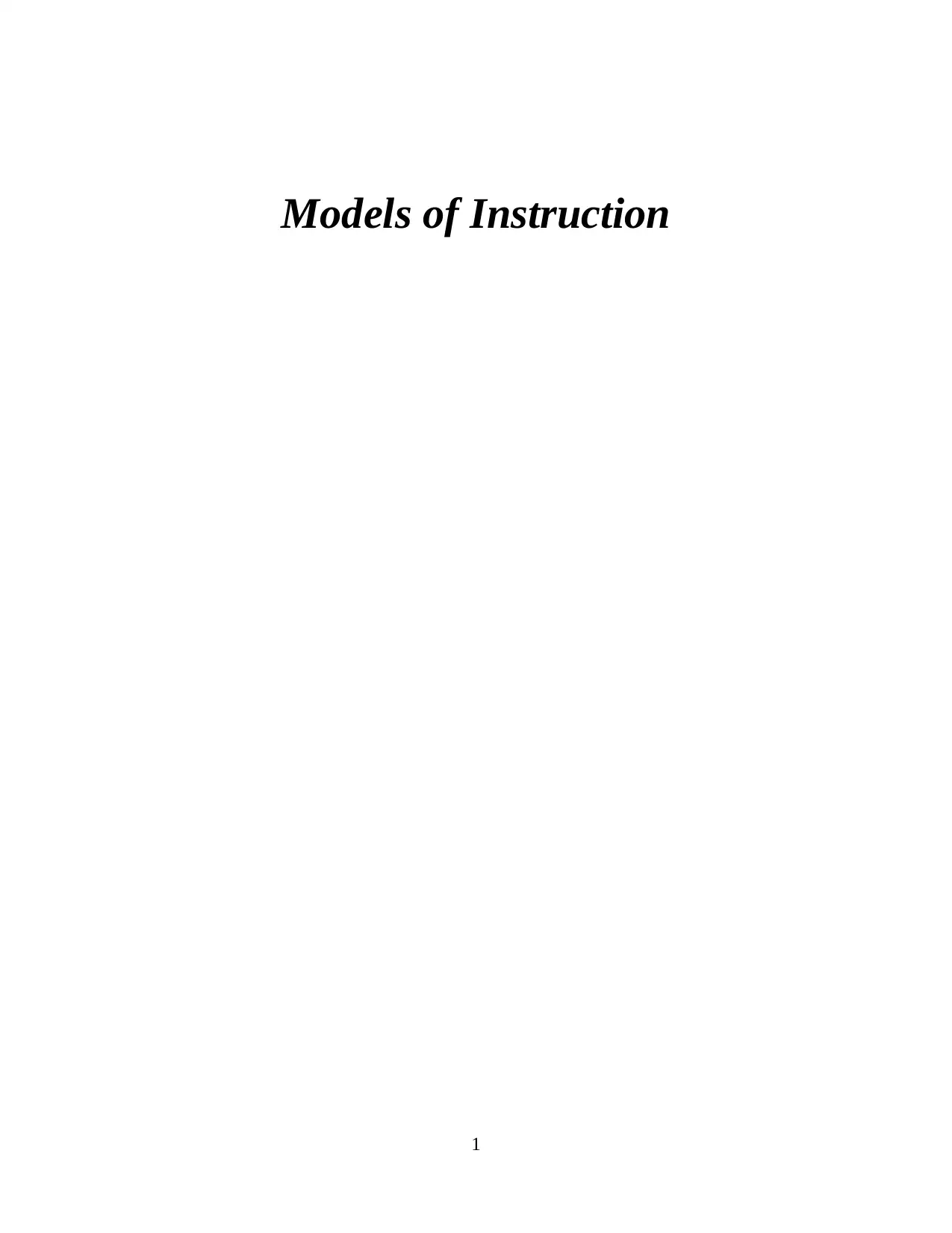
Models of Instruction
1
1
Paraphrase This Document
Need a fresh take? Get an instant paraphrase of this document with our AI Paraphraser
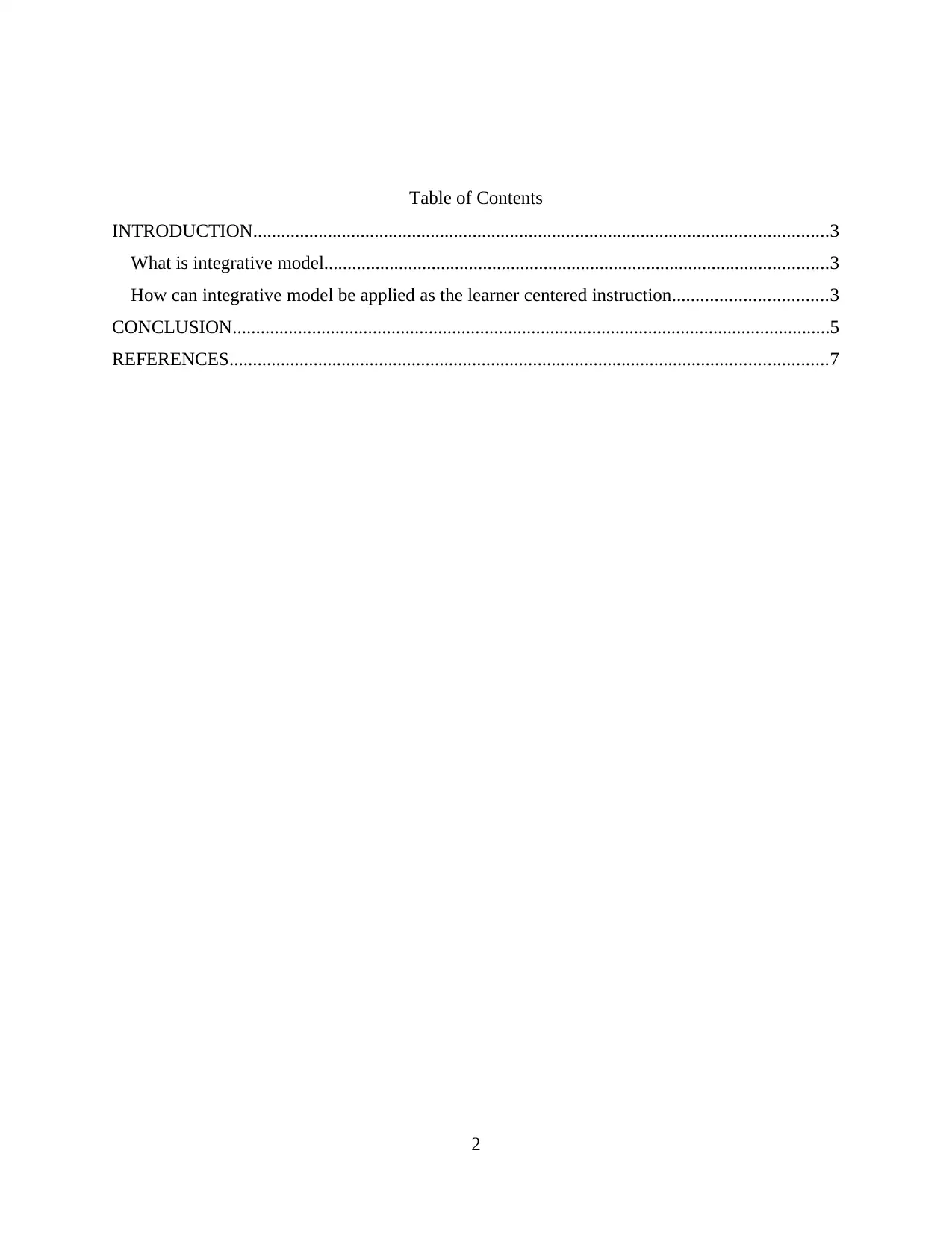
Table of Contents
INTRODUCTION...........................................................................................................................3
What is integrative model............................................................................................................3
How can integrative model be applied as the learner centered instruction.................................3
CONCLUSION................................................................................................................................5
REFERENCES................................................................................................................................7
2
INTRODUCTION...........................................................................................................................3
What is integrative model............................................................................................................3
How can integrative model be applied as the learner centered instruction.................................3
CONCLUSION................................................................................................................................5
REFERENCES................................................................................................................................7
2
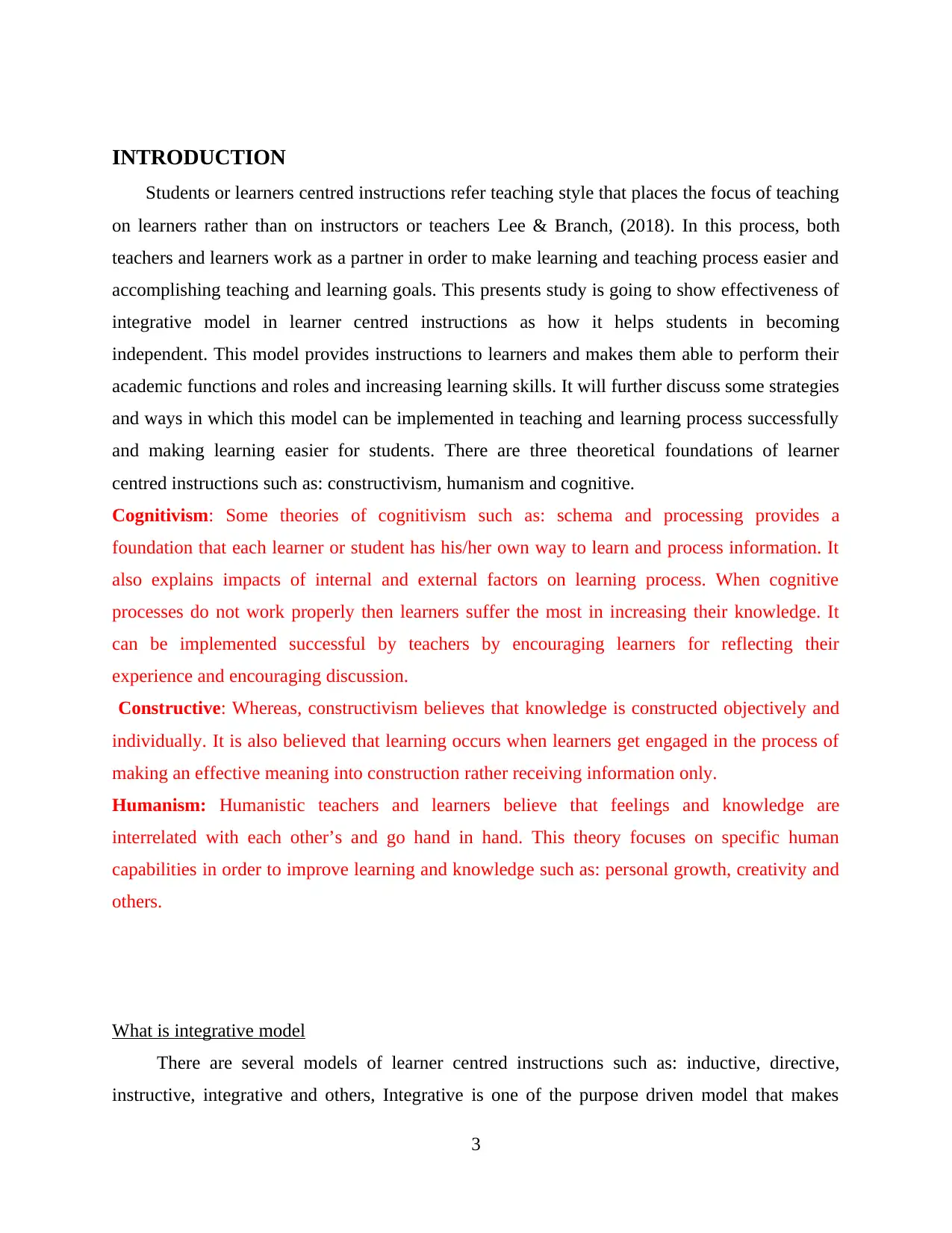
INTRODUCTION
Students or learners centred instructions refer teaching style that places the focus of teaching
on learners rather than on instructors or teachers Lee & Branch, (2018). In this process, both
teachers and learners work as a partner in order to make learning and teaching process easier and
accomplishing teaching and learning goals. This presents study is going to show effectiveness of
integrative model in learner centred instructions as how it helps students in becoming
independent. This model provides instructions to learners and makes them able to perform their
academic functions and roles and increasing learning skills. It will further discuss some strategies
and ways in which this model can be implemented in teaching and learning process successfully
and making learning easier for students. There are three theoretical foundations of learner
centred instructions such as: constructivism, humanism and cognitive.
Cognitivism: Some theories of cognitivism such as: schema and processing provides a
foundation that each learner or student has his/her own way to learn and process information. It
also explains impacts of internal and external factors on learning process. When cognitive
processes do not work properly then learners suffer the most in increasing their knowledge. It
can be implemented successful by teachers by encouraging learners for reflecting their
experience and encouraging discussion.
Constructive: Whereas, constructivism believes that knowledge is constructed objectively and
individually. It is also believed that learning occurs when learners get engaged in the process of
making an effective meaning into construction rather receiving information only.
Humanism: Humanistic teachers and learners believe that feelings and knowledge are
interrelated with each other’s and go hand in hand. This theory focuses on specific human
capabilities in order to improve learning and knowledge such as: personal growth, creativity and
others.
What is integrative model
There are several models of learner centred instructions such as: inductive, directive,
instructive, integrative and others, Integrative is one of the purpose driven model that makes
3
Students or learners centred instructions refer teaching style that places the focus of teaching
on learners rather than on instructors or teachers Lee & Branch, (2018). In this process, both
teachers and learners work as a partner in order to make learning and teaching process easier and
accomplishing teaching and learning goals. This presents study is going to show effectiveness of
integrative model in learner centred instructions as how it helps students in becoming
independent. This model provides instructions to learners and makes them able to perform their
academic functions and roles and increasing learning skills. It will further discuss some strategies
and ways in which this model can be implemented in teaching and learning process successfully
and making learning easier for students. There are three theoretical foundations of learner
centred instructions such as: constructivism, humanism and cognitive.
Cognitivism: Some theories of cognitivism such as: schema and processing provides a
foundation that each learner or student has his/her own way to learn and process information. It
also explains impacts of internal and external factors on learning process. When cognitive
processes do not work properly then learners suffer the most in increasing their knowledge. It
can be implemented successful by teachers by encouraging learners for reflecting their
experience and encouraging discussion.
Constructive: Whereas, constructivism believes that knowledge is constructed objectively and
individually. It is also believed that learning occurs when learners get engaged in the process of
making an effective meaning into construction rather receiving information only.
Humanism: Humanistic teachers and learners believe that feelings and knowledge are
interrelated with each other’s and go hand in hand. This theory focuses on specific human
capabilities in order to improve learning and knowledge such as: personal growth, creativity and
others.
What is integrative model
There are several models of learner centred instructions such as: inductive, directive,
instructive, integrative and others, Integrative is one of the purpose driven model that makes
3
⊘ This is a preview!⊘
Do you want full access?
Subscribe today to unlock all pages.

Trusted by 1+ million students worldwide
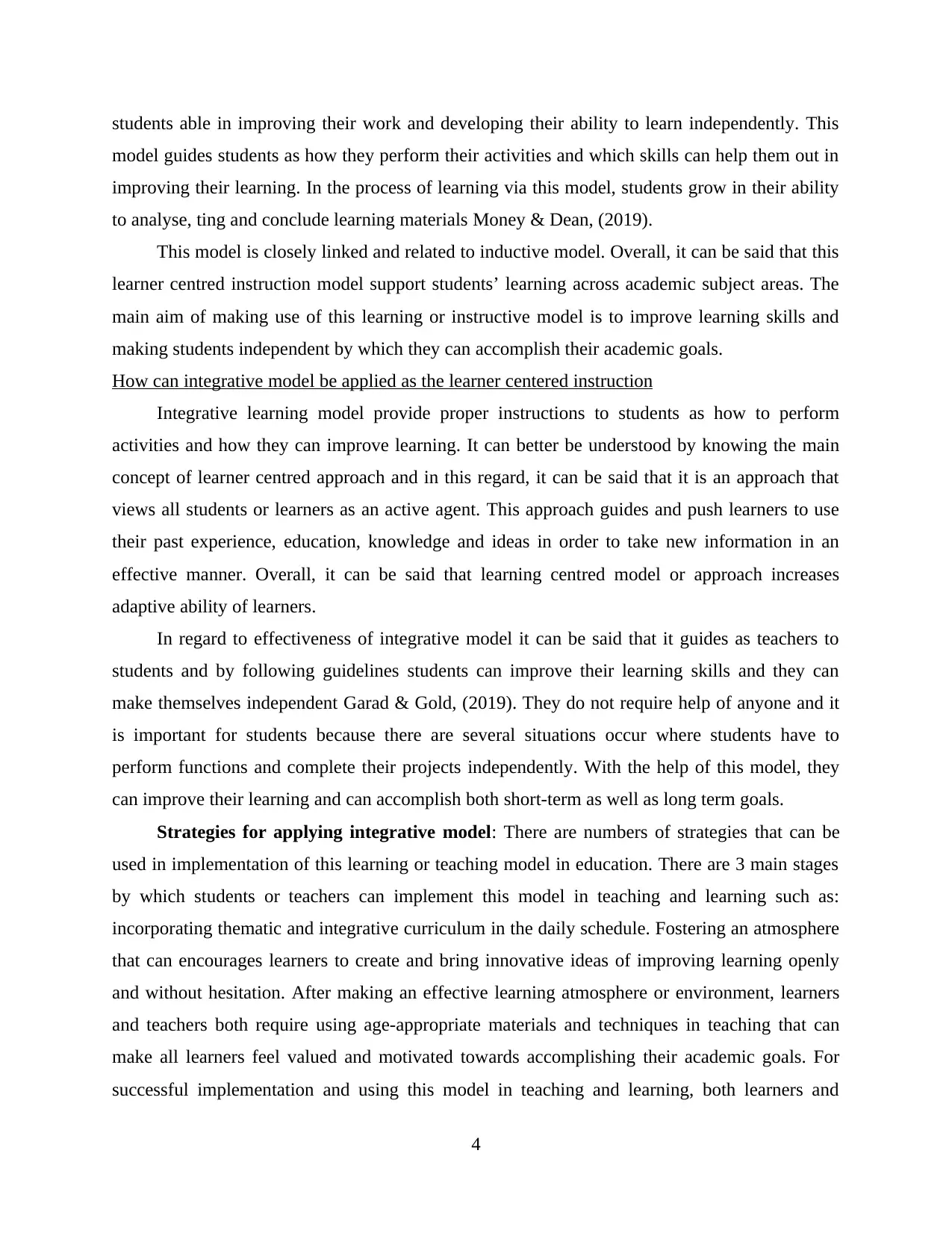
students able in improving their work and developing their ability to learn independently. This
model guides students as how they perform their activities and which skills can help them out in
improving their learning. In the process of learning via this model, students grow in their ability
to analyse, ting and conclude learning materials Money & Dean, (2019).
This model is closely linked and related to inductive model. Overall, it can be said that this
learner centred instruction model support students’ learning across academic subject areas. The
main aim of making use of this learning or instructive model is to improve learning skills and
making students independent by which they can accomplish their academic goals.
How can integrative model be applied as the learner centered instruction
Integrative learning model provide proper instructions to students as how to perform
activities and how they can improve learning. It can better be understood by knowing the main
concept of learner centred approach and in this regard, it can be said that it is an approach that
views all students or learners as an active agent. This approach guides and push learners to use
their past experience, education, knowledge and ideas in order to take new information in an
effective manner. Overall, it can be said that learning centred model or approach increases
adaptive ability of learners.
In regard to effectiveness of integrative model it can be said that it guides as teachers to
students and by following guidelines students can improve their learning skills and they can
make themselves independent Garad & Gold, (2019). They do not require help of anyone and it
is important for students because there are several situations occur where students have to
perform functions and complete their projects independently. With the help of this model, they
can improve their learning and can accomplish both short-term as well as long term goals.
Strategies for applying integrative model: There are numbers of strategies that can be
used in implementation of this learning or teaching model in education. There are 3 main stages
by which students or teachers can implement this model in teaching and learning such as:
incorporating thematic and integrative curriculum in the daily schedule. Fostering an atmosphere
that can encourages learners to create and bring innovative ideas of improving learning openly
and without hesitation. After making an effective learning atmosphere or environment, learners
and teachers both require using age-appropriate materials and techniques in teaching that can
make all learners feel valued and motivated towards accomplishing their academic goals. For
successful implementation and using this model in teaching and learning, both learners and
4
model guides students as how they perform their activities and which skills can help them out in
improving their learning. In the process of learning via this model, students grow in their ability
to analyse, ting and conclude learning materials Money & Dean, (2019).
This model is closely linked and related to inductive model. Overall, it can be said that this
learner centred instruction model support students’ learning across academic subject areas. The
main aim of making use of this learning or instructive model is to improve learning skills and
making students independent by which they can accomplish their academic goals.
How can integrative model be applied as the learner centered instruction
Integrative learning model provide proper instructions to students as how to perform
activities and how they can improve learning. It can better be understood by knowing the main
concept of learner centred approach and in this regard, it can be said that it is an approach that
views all students or learners as an active agent. This approach guides and push learners to use
their past experience, education, knowledge and ideas in order to take new information in an
effective manner. Overall, it can be said that learning centred model or approach increases
adaptive ability of learners.
In regard to effectiveness of integrative model it can be said that it guides as teachers to
students and by following guidelines students can improve their learning skills and they can
make themselves independent Garad & Gold, (2019). They do not require help of anyone and it
is important for students because there are several situations occur where students have to
perform functions and complete their projects independently. With the help of this model, they
can improve their learning and can accomplish both short-term as well as long term goals.
Strategies for applying integrative model: There are numbers of strategies that can be
used in implementation of this learning or teaching model in education. There are 3 main stages
by which students or teachers can implement this model in teaching and learning such as:
incorporating thematic and integrative curriculum in the daily schedule. Fostering an atmosphere
that can encourages learners to create and bring innovative ideas of improving learning openly
and without hesitation. After making an effective learning atmosphere or environment, learners
and teachers both require using age-appropriate materials and techniques in teaching that can
make all learners feel valued and motivated towards accomplishing their academic goals. For
successful implementation and using this model in teaching and learning, both learners and
4
Paraphrase This Document
Need a fresh take? Get an instant paraphrase of this document with our AI Paraphraser
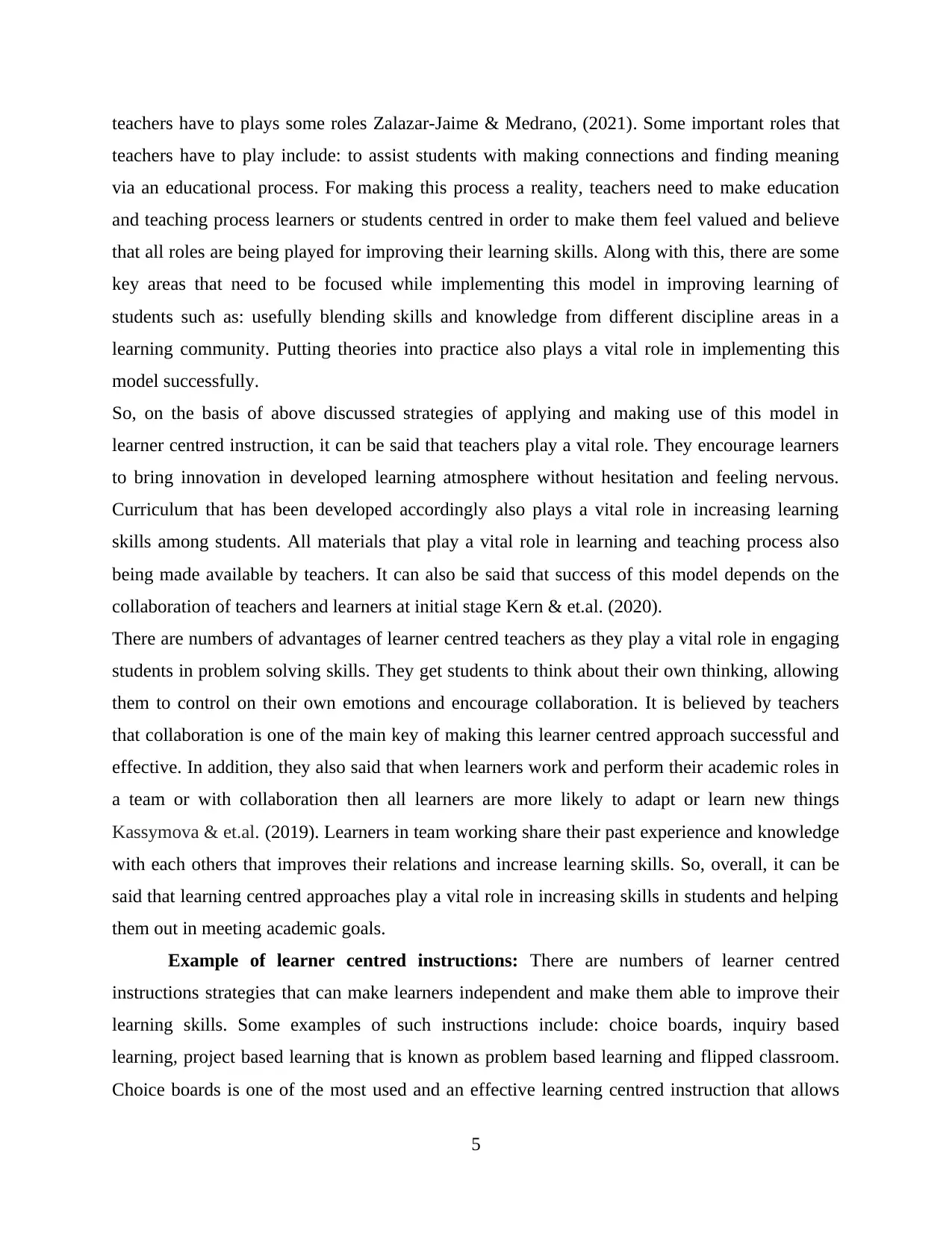
teachers have to plays some roles Zalazar-Jaime & Medrano, (2021). Some important roles that
teachers have to play include: to assist students with making connections and finding meaning
via an educational process. For making this process a reality, teachers need to make education
and teaching process learners or students centred in order to make them feel valued and believe
that all roles are being played for improving their learning skills. Along with this, there are some
key areas that need to be focused while implementing this model in improving learning of
students such as: usefully blending skills and knowledge from different discipline areas in a
learning community. Putting theories into practice also plays a vital role in implementing this
model successfully.
So, on the basis of above discussed strategies of applying and making use of this model in
learner centred instruction, it can be said that teachers play a vital role. They encourage learners
to bring innovation in developed learning atmosphere without hesitation and feeling nervous.
Curriculum that has been developed accordingly also plays a vital role in increasing learning
skills among students. All materials that play a vital role in learning and teaching process also
being made available by teachers. It can also be said that success of this model depends on the
collaboration of teachers and learners at initial stage Kern & et.al. (2020).
There are numbers of advantages of learner centred teachers as they play a vital role in engaging
students in problem solving skills. They get students to think about their own thinking, allowing
them to control on their own emotions and encourage collaboration. It is believed by teachers
that collaboration is one of the main key of making this learner centred approach successful and
effective. In addition, they also said that when learners work and perform their academic roles in
a team or with collaboration then all learners are more likely to adapt or learn new things
Kassymova & et.al. (2019). Learners in team working share their past experience and knowledge
with each others that improves their relations and increase learning skills. So, overall, it can be
said that learning centred approaches play a vital role in increasing skills in students and helping
them out in meeting academic goals.
Example of learner centred instructions: There are numbers of learner centred
instructions strategies that can make learners independent and make them able to improve their
learning skills. Some examples of such instructions include: choice boards, inquiry based
learning, project based learning that is known as problem based learning and flipped classroom.
Choice boards is one of the most used and an effective learning centred instruction that allows
5
teachers have to play include: to assist students with making connections and finding meaning
via an educational process. For making this process a reality, teachers need to make education
and teaching process learners or students centred in order to make them feel valued and believe
that all roles are being played for improving their learning skills. Along with this, there are some
key areas that need to be focused while implementing this model in improving learning of
students such as: usefully blending skills and knowledge from different discipline areas in a
learning community. Putting theories into practice also plays a vital role in implementing this
model successfully.
So, on the basis of above discussed strategies of applying and making use of this model in
learner centred instruction, it can be said that teachers play a vital role. They encourage learners
to bring innovation in developed learning atmosphere without hesitation and feeling nervous.
Curriculum that has been developed accordingly also plays a vital role in increasing learning
skills among students. All materials that play a vital role in learning and teaching process also
being made available by teachers. It can also be said that success of this model depends on the
collaboration of teachers and learners at initial stage Kern & et.al. (2020).
There are numbers of advantages of learner centred teachers as they play a vital role in engaging
students in problem solving skills. They get students to think about their own thinking, allowing
them to control on their own emotions and encourage collaboration. It is believed by teachers
that collaboration is one of the main key of making this learner centred approach successful and
effective. In addition, they also said that when learners work and perform their academic roles in
a team or with collaboration then all learners are more likely to adapt or learn new things
Kassymova & et.al. (2019). Learners in team working share their past experience and knowledge
with each others that improves their relations and increase learning skills. So, overall, it can be
said that learning centred approaches play a vital role in increasing skills in students and helping
them out in meeting academic goals.
Example of learner centred instructions: There are numbers of learner centred
instructions strategies that can make learners independent and make them able to improve their
learning skills. Some examples of such instructions include: choice boards, inquiry based
learning, project based learning that is known as problem based learning and flipped classroom.
Choice boards is one of the most used and an effective learning centred instruction that allows
5
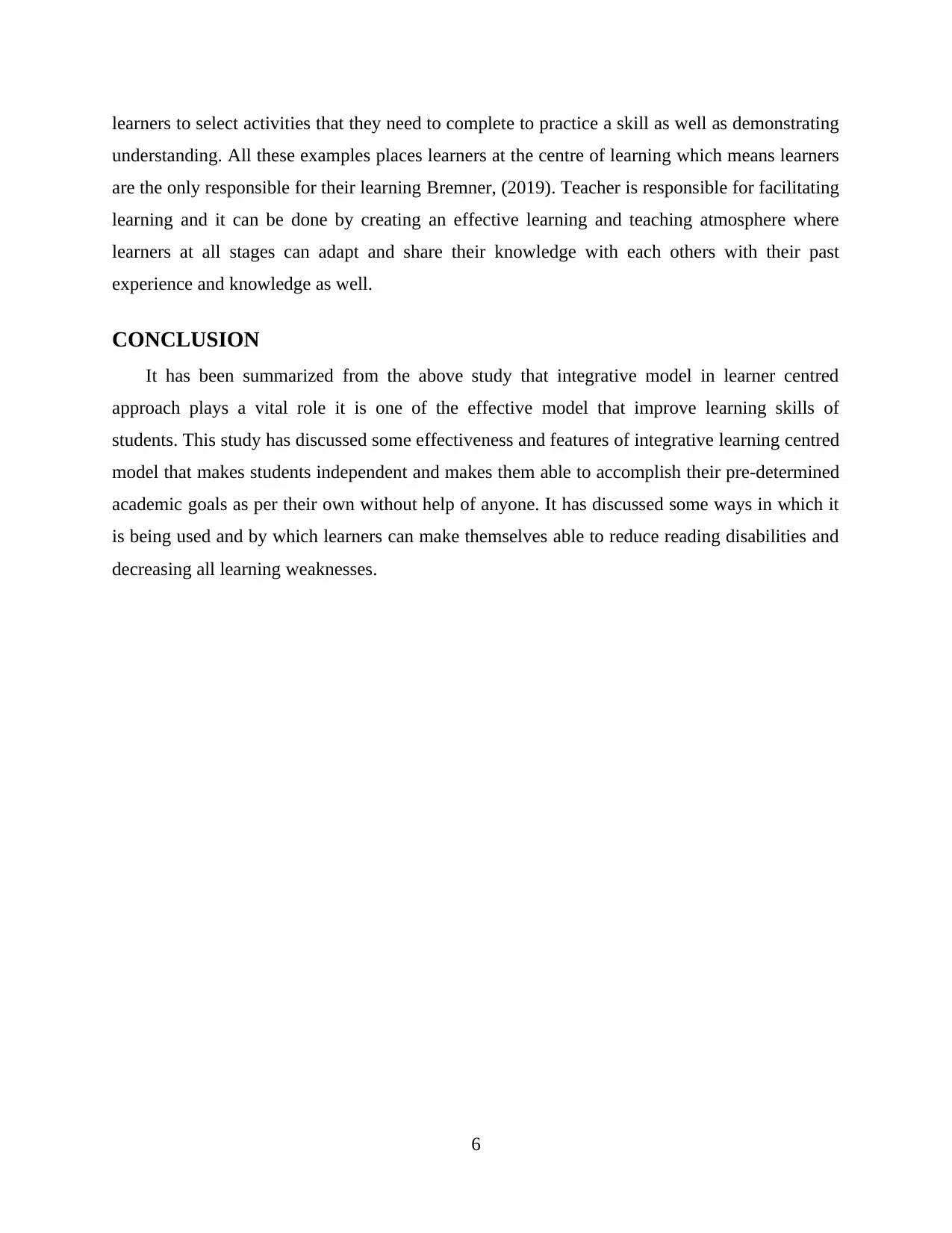
learners to select activities that they need to complete to practice a skill as well as demonstrating
understanding. All these examples places learners at the centre of learning which means learners
are the only responsible for their learning Bremner, (2019). Teacher is responsible for facilitating
learning and it can be done by creating an effective learning and teaching atmosphere where
learners at all stages can adapt and share their knowledge with each others with their past
experience and knowledge as well.
CONCLUSION
It has been summarized from the above study that integrative model in learner centred
approach plays a vital role it is one of the effective model that improve learning skills of
students. This study has discussed some effectiveness and features of integrative learning centred
model that makes students independent and makes them able to accomplish their pre-determined
academic goals as per their own without help of anyone. It has discussed some ways in which it
is being used and by which learners can make themselves able to reduce reading disabilities and
decreasing all learning weaknesses.
6
understanding. All these examples places learners at the centre of learning which means learners
are the only responsible for their learning Bremner, (2019). Teacher is responsible for facilitating
learning and it can be done by creating an effective learning and teaching atmosphere where
learners at all stages can adapt and share their knowledge with each others with their past
experience and knowledge as well.
CONCLUSION
It has been summarized from the above study that integrative model in learner centred
approach plays a vital role it is one of the effective model that improve learning skills of
students. This study has discussed some effectiveness and features of integrative learning centred
model that makes students independent and makes them able to accomplish their pre-determined
academic goals as per their own without help of anyone. It has discussed some ways in which it
is being used and by which learners can make themselves able to reduce reading disabilities and
decreasing all learning weaknesses.
6
⊘ This is a preview!⊘
Do you want full access?
Subscribe today to unlock all pages.

Trusted by 1+ million students worldwide
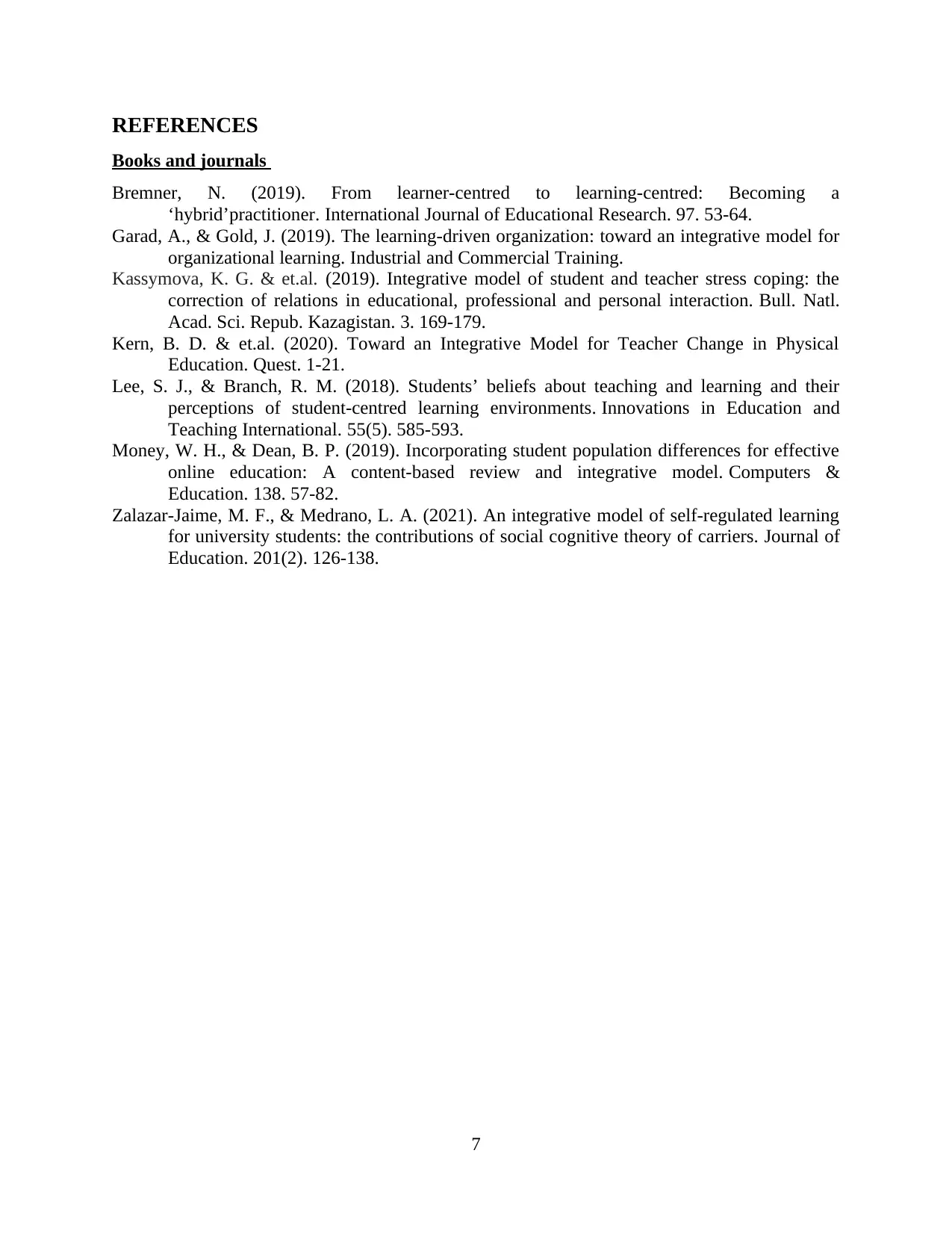
REFERENCES
Books and journals
Bremner, N. (2019). From learner-centred to learning-centred: Becoming a
‘hybrid’practitioner. International Journal of Educational Research. 97. 53-64.
Garad, A., & Gold, J. (2019). The learning-driven organization: toward an integrative model for
organizational learning. Industrial and Commercial Training.
Kassymova, K. G. & et.al. (2019). Integrative model of student and teacher stress coping: the
correction of relations in educational, professional and personal interaction. Bull. Natl.
Acad. Sci. Repub. Kazagistan. 3. 169-179.
Kern, B. D. & et.al. (2020). Toward an Integrative Model for Teacher Change in Physical
Education. Quest. 1-21.
Lee, S. J., & Branch, R. M. (2018). Students’ beliefs about teaching and learning and their
perceptions of student-centred learning environments. Innovations in Education and
Teaching International. 55(5). 585-593.
Money, W. H., & Dean, B. P. (2019). Incorporating student population differences for effective
online education: A content-based review and integrative model. Computers &
Education. 138. 57-82.
Zalazar-Jaime, M. F., & Medrano, L. A. (2021). An integrative model of self-regulated learning
for university students: the contributions of social cognitive theory of carriers. Journal of
Education. 201(2). 126-138.
7
Books and journals
Bremner, N. (2019). From learner-centred to learning-centred: Becoming a
‘hybrid’practitioner. International Journal of Educational Research. 97. 53-64.
Garad, A., & Gold, J. (2019). The learning-driven organization: toward an integrative model for
organizational learning. Industrial and Commercial Training.
Kassymova, K. G. & et.al. (2019). Integrative model of student and teacher stress coping: the
correction of relations in educational, professional and personal interaction. Bull. Natl.
Acad. Sci. Repub. Kazagistan. 3. 169-179.
Kern, B. D. & et.al. (2020). Toward an Integrative Model for Teacher Change in Physical
Education. Quest. 1-21.
Lee, S. J., & Branch, R. M. (2018). Students’ beliefs about teaching and learning and their
perceptions of student-centred learning environments. Innovations in Education and
Teaching International. 55(5). 585-593.
Money, W. H., & Dean, B. P. (2019). Incorporating student population differences for effective
online education: A content-based review and integrative model. Computers &
Education. 138. 57-82.
Zalazar-Jaime, M. F., & Medrano, L. A. (2021). An integrative model of self-regulated learning
for university students: the contributions of social cognitive theory of carriers. Journal of
Education. 201(2). 126-138.
7
1 out of 7
Related Documents
Your All-in-One AI-Powered Toolkit for Academic Success.
+13062052269
info@desklib.com
Available 24*7 on WhatsApp / Email
![[object Object]](/_next/static/media/star-bottom.7253800d.svg)
Unlock your academic potential
Copyright © 2020–2025 A2Z Services. All Rights Reserved. Developed and managed by ZUCOL.




